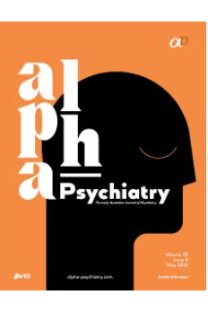The adaptation of the Triangular Relationship Inventory into Turkish: the study of validity and reliability for university students
Üçgen İlişki Ölçeğinin Türkçeye uyarlanması: Üniversite öğrencileri için geçerlilik ve güvenilirlik çalışması
___
1. Kerr ME, Bowen M. Family Evaluation: An Approach Based on Bowen Theory. New York: W.W. Norton & Co, 1988.2. Bowen M. Family Therapy in Clinical Practice. New York: Jason Aronson, 1978.
3. Bell LG, Bell DC, Nakata YA. Triangulation and adolescent development in the USA and Japan. Fam Process 2001; 40:173-186.
4. Buehler C, Welsh DP. A process model of adolescents’ triangulation into parents’ marital conflict: The role of emotional reactivity. J Fam Psychol 2009; 23:167-180.
5. Fosco GM, Grych JH. Emotional, cognitive, and family systems mediators of children’s adjustment to interparental conflict. J Fam Psychol 2008; 22:843-854.
6. Józefik B. Intergenerational family patterns in eating disorders families and schizophrenic families. Archives of Psychiatry and Psychotherapy 2001; 3:27-39.
7. Wang L, Crane DR. The relationship between marital satisfaction, marital stability, nuclear family triangulation, and childhood depression. Am J Fam Ther 2001; 29:337-347.
8. Bresin RC, Murdock NL, Marszalek JM, Stapley, LA. The triangular relationship inventory: Development and validation. Couple Family Psychol 2017; 6:287-310.
9. Erdem G, Safi OA. The cultural lens approach to Bowen family systems theory: Contributions of family change theory. Journal of Family Theory and Review 2018; 10:469-483
10. Bray JH, Harvey, DM. Intimacy and individuation in young adults: Development of the young adult version of the Personal Authority in the Family System Questionnaire. J Fam Psychol 1992; 6:152-163.
11. Kurşuncu MA. Risk Involvement in Emerging Adulthood: The Role of Personal Authority, Intergenerational Intimacy and Family Triangulation. Unpublished Master’s Thesis, Ankara, Middle East Technical University, Institute of Educational Sciences, 2016.
12. Crowne DP, Marlowe D. A new scale of social desirability independent of psychopathology. J Consult Psychol 1960; 24:349-354.
13. Ural T, Özbirecikli M. Is ethical judgement influenced by social desirability in responding? An analysis on Turkish accountants. Çukurova Üniversitesi Sosyal Bilimler Enstitüsü Dergisi 2006; 15:393-410.
14. Davis LL. Instrument review: Getting the most from your panel of experts. Appl Nurs Res 1992; 5:194- 197.
15. IBM Corp. Released. IBM SPSS Statistics for Windows, Version 22.0. Armonk, New York: IBM Corp., 2013.
16. JASP Team. JASP (Version 0.11.1) [Computer software], 2019.
17. Tabachnick BG, Fidell LS. Using Multivariate Statistics. Sixth ed., Boston: Pearson/Allyn & Bacon, 2013.
18. Hoelter JW. The analysis of covariance structures: Goodness-of-fit indices. Sociological Methods & Research 1983; 11:325-344.
19. Kline RB. Principles and Practice of Structural Equation Modeling. Third ed., New York: Guilford Press, 2011.
20. Mardia KV. Mardia’s test of multinormality. S Kotz, NL Johnson (Eds.), Encyclopedia of Statistical Sciences, New York: Wiley, 1985.
21. Byrne BM. Structural Equation Modeling with AMOS: Basic Concepts, Applications and Programming. Mahwah: Lawrence Erlbaum, 2010.
22. Kline RB. Principles and Practice of Structural Equation Modeling. New York: Guilford Press, 1988.
23. Ullman JB. Structural equation modeling. BG Tabachnick, LS Fidell (Eds.), Using Multivariate Statistics, Needham Heights: Allyn & Bacon, 2001, pp.653-771.
24. Schumacker RE, Lomax RG. A Beginner’s Guide to Structural Equation Modeling. Third ed., New York: Routledge, 2010.
25. Byrne BM. Structural Equation Modeling with EQS and EQS/WINDOWS: Basic Concepts, Applications, and Programming. Thousand Oaks: Sage Publications, 1994.
26. Hu L, Bentler PM. Cutoff criteria for fit indexes in covariance structure analysis: Conventional criteria versus new alternatives. Structural Equation Modeling: A Multidisciplinary Journal 1999;6:1-55.
27. Milfont TL, Fischer R. Testing measurement invariance across groups: Applications in cross-cultural research. Int J Psychol Res 2010; 3:111-121.
28. Cohen J. Statistical Power Analysis for the Behavioral Sciences. Hillsdale: Lawrence Earlbaum, 1988.
29. Platt L, Skowron E. The Family Genogram Interview: Reliability and validity of a new interview protocol. T Fam J 2013; 21:35-45.
30. Kurşuncu MA, Baştemur S. Family triangulation experiences of Turkish young women. Educational Policy Analysis and Strategic Research 2019; 14:312-329.
31. Mroczek DK. The analysis of longitudinal data in personality research. RW Robins, C Fraley, RF Krueger (Eds.), Handbook of Research Methods in Personality Psychology. New York: Guilford Press, 2009, pp.543-556.
- ISSN: 1302-6631
- Yayın Aralığı: 6
- Başlangıç: 2000
- Yayıncı: -
Gönül BODUR, Arzu Kader HARMANCI SEREN
Damla ALKAN, Sema KANER, Ebru T. ÇAKICI
Relational Needs Satisfaction Scale: reliability and validity study in Turkish
Şafak Ebru TOKSOY, Cem CERİT, Ahmet Tamer AKER, Gregor ZVELC
Ergenlerde Sosyal Medya Bağımlılık Ölçeğinin geliştirilmesi: Geçerlilik ve güvenilirlik çalışması
Dilek ORBATU, Kayı ELİAÇIK, Demet ALAYGUT EYLENOĞLU, Hacer HORTU, Yavuz DEMİRÇELİK, Nurullah BOLAT, Ferhan ELMALI, Mehmet Rami HELVACI
Siber Zorbalık Ölçeğinin Türk kültürüne uyarlanması: Psikometrik özellikleri
Bahtiyar ERASLAN ÇAPAN, Fuad BAKİOĞLU, Sami KIRTEKE
Validation of Turkish Version of Me and My Feelings Scale on Children and Adolescents
Gaf Tanıma Testi Çocuk Formunun Türkçeye uyarlanması ve psikometrik özelliklerinin incelenmesi
Berkan ŞAHİN, Bedia SULTAN ÖNAL, Esra HOŞOĞLU
Ruh Sağlığı Okuryazarlığı Ölçeğinin Türkçe uyarlaması: Geçerlilik ve güvenilirlik çalışması
